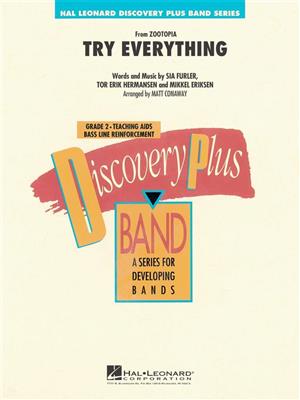Results
-
 £56.50
£56.50Travelin' Music
The Arkansas Traveler is one of the most popular and well known of all Arkansas folk songs. Originally a fiddle tune, this rendition is set in a cajun groove, and uses a number of compositional techniques to explore and develop the tune in many unexpected ways. Great fun to play, and certain to delight audiences! (2:50)
Estimated dispatch 7-14 working days
-
 £49.95
£49.95Tango Argentina - Robert Sheldon
The tango originated in late 19th century Buenos Aires, and has become popular around the world due to its driving rhythms, distinctive sound, and the passionate dance steps it inspires. This piece allows even young bands to experience the style and attitude of this wonderful musical genre. (2:45)
Estimated dispatch 7-14 working days
-
 £102.99
£102.99Don't You Worry 'Bout A Thing - Stevie Wonder
Don't You Worry 'Bout A Thing is one of the most popular songs by Stevie Wonder and has been performed by various other famous artists throughout the years. The version from Al Jarreau is probably the most well known, and has been arranged by the Norwegian arranger Richard Johnsen.
Estimated dispatch 7-14 working days
-
 £60.99
£60.99Try Everything (from Zootopia) - Sia Furler
Recorded by Shakira for the popular movie Zootopia, this arrangement for young band features a moderate dance tempo with a Latin flavor, and is supported by a steady percussion groove with plenty of options for additional players.
Estimated dispatch 7-14 working days
-
 £127.30
£127.30Lei, milde ljos - Charles Henry Purday
Lead, Kindly Light is composed by the English composer Charles Henry Purday (1799-1885).This arrangement was originally written for Brass Band to Norwegian band Hjrungavg Brass.Purday was appointed conductor of psalmody at CrownCourt Scots Church in Covent Garden, London, in the 1840's, during the ministry of Dr. John Cumming. Dr. Cumming's church was so popular that it was said traffic could not move in Bow Street and Drury Lane for the throng of carriages making their wayto services. Purday was a fine vocalist and had sung at the coronation of Queen Victoria. He became a music publisher, and was a pioneer in the movement for copyright law reform.
Estimated dispatch 7-14 working days
-
 £64.50
£64.50You Better You Bet
Composed by guitarist Pete Townshend and recorded by the iconic rock band The Who this blockbuster chart was originally released on their 1981 album, Face Dances. Written as a love song for his girlfriend, Townshend's melody and lyrics have become one of the band's most popular songs. This adaptation brings all of the drive and fun from the original recording to this accessible arrangement for young bands. (3:30)
Estimated dispatch 7-14 working days
-
 £53.50
£53.50Themes from How To Train Your Dragon - John Powell
The popular animated film How to Train Your Dragon gave us a marvelous score by John Powell. This concise arrangement for second-year players features the primary themes in an easy and appealing setting.
Estimated dispatch 7-14 working days
-
 £385.00
£385.00Symphonic Dances Op. 45 - Movement 3 - Sergei Rachmaninov
Paul Lavender arranged the third movement (Allegro Assai) of the popular Symphonic Dances by Sergey Rachmaninoff for wind orchestra. He successfully managed to apply the original's dynamics and drama to the wind orchestra.Suitable for very advanced / professional wind orchestra.
Estimated dispatch 7-14 working days
-
 £87.99
£87.99Pavane pour une Infante Dfunte - Maurice Ravel
Pavane pour une Infante Dfunte (Pavane for a Dead Princess) is one of Ravel's most popular pieces alongside Bolro. Written in 1899, the original piano version was arranged for orchestra by the composer and became a highlight of theFrench classical repertoire. Johan de Meij has created a special version for the world-famous trombone soloist Joe Alessi. This unique arrangement for solo trombone (Difficulty: 5) and wind orchestra sounds as if it was originally intended for thisinstrumentation. This work can also be performed with solo flugelhorn (Difficulty 3+), or wind orchestra only. Breathtakingly beautiful!
Estimated dispatch 7-14 working days
-
 £149.40
£149.40The Cardamom Song - Thorbjørn Egner
"The Cardamom song" is a very popular children's song in the Nordic countries. It's taken from the music and book "Folk og rvere i Kardemomme by" written by Thorbjrn Egner.This arrangement written in a latin style features a childrens choirwith concert band.The arrangement was written for the recording "Muntre musikanter Karius og Baktus mter dyrene I Afrika" by Forsvarets Musikkorps Nord-Norge.
Estimated dispatch 7-14 working days
